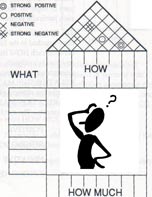Your boss demands a House of Quality (HoQ)…
What you can/should do?
"Our manager insists we do a House of Quality for a project that is about to be launched. He's seen the HoQ in books and is telling us we can copy it. No one here has any experience with QFD, including him."
"My new boss did QFD at another company some 20 years ago. He wants to implement it here but all he has is a training book by a consultant who has long retired."
"Are there better QFD tools today that do not require a House of Quality matrix? Where can I learn them?"
The challenge that these readers face is more and more common. It is unfortunate that virtually all English language books on QFD reference a traditional "House of Quality" matrix and "4-House model." These were created over 30 years ago by build-to-print American auto parts suppliers. Besides the wrong math being used, these methods no longer address the challenges that today’s product development teams face, such as true user needs, design, innovation, reliability, security, supply chain, technical support, sustainability, etc.
The new ISO 16355 makes these traditional methods obsolete for a good reason. New product development professionals and DFLS/DFSS champions must take a notice and update their knowledge and skills now, in order for your business to be in compliance with the ISO.
Here is what someone we met at a quality conference has told us. We share it here because these perils are rather common when people attempt to implement QFD for the first time without proper training and guidance:
"We had extensive Voice of Customer (VoC) data. Our marketing group spent a lot of time collecting them. We prepared ourselves with many books, downloaded an online House of Quality with instructions and a college lecture YouTube. We thought we had a good head start.
"But as soon as we began transferring the VoC data into the downloaded template, we realized we were in trouble.

"We did not know which of the customer voices to pursue or discard, how to sort them, how to convert them into needs or specifications, etc. Some of the WHATs (customer needs) looked like HOWs (product specifications), and we had no WHYs (the customer's problem).
"Our confusion increased as we deployed to House 2. Houses 3 and 4 didn't fit our project at all. The downloaded template and instructions sounded good on paper, but made no sense on a real project.
"We wasted so much effort that we ran short of the development time and were forced to jump to finalizing engineering specifications. Because our colleagues had high hopes for our QFD project, we ended up looking to the TRIZ list of inventive principles and matching them to some of the raw customer voice data, just so that we could make a big matrix to please our boss and get his approval to continue to fund the project.
"The irony is our superiors could not tell our 'by the book' matrix from a real HoQ even though they said they knew QFD. But now we are seriously worried about the outcome of the project, as it proceeds with this made-up analysis.."
Senior managers who learned QFD decades ago can and do respond to improvements.
Here are ways to help:
- Encourage your boss to take the QFD White Belt® seminar. This seminar is designed for senior managers and executives who do not need to know specific QFD techniques nor become a hands-on expert. It introduces them to the benefits that QFD can bring to a customer-driven organization. The QFD White Belt® course is scheduled to accommodate busy executives.
- Show a quick "win" by tackling small project. Use Blitz QFD® first to address what matters most to customer. Promise to follow up with a House of Quality afterwards. These mini grids in the Blitz QFD® will be your fast tools for grasping the most challenging, fuzzy front-end of customer needs analysis. The Blitz QFD® tools are taught in the QFD Green Belt® training, which includes the free templates for Modern QFD, including Customer Voice table, AHP, Maximum Value table, and a modernized House of Quality with correct math.
- ISO 16355 Compliance. This standard details with examples the best practice of QFD, including the correct situation and method to use a House of Quality. It identifies deployments for physical products, services (including healthcare), software and information systems, and internal business processes.
The above steps will demonstrate that QFD "by-the-book" is rarely a workable approach in a modern business. While online tutorials, videos, and templates may look easy to follow, experience tells us that without the context and nuance of your company, your products, and your customers, this by-the-book QFD will yield lackluster, not blockbuster results.
Your real market opportunity costs and resource commitments far outweigh free downloads and one-size-fits-all templates.
Should a House of Quality still be required by your boss, please consider the following:
The House of Quality matrix is constructed of WHYs and WHATs (not Whats and Hows).
No priorities can be derived until the entire matrix is completed.
The ordinal scale math (virtually all book examples use this bad math) is incorrect and skews the priority calculations, making invalid your downstream analysis and deployment.
The House of Quality addresses only two design dimensions. Additional matrices are required to complete the QFD study whenever you use the House of Quality -- even though none of the QFD book authors mention this important fact.
Finally, in this age of Lean Thinking and constrained resources, doesn't it make more sense to get a quick start on innovating solutions to key customer needs by first using Blitz QFD®?
As projects change in scope, resources get reassigned, competitors disrupt our best plans, and technologies evolve, what our bosses really need is an agile approach to new product development.

